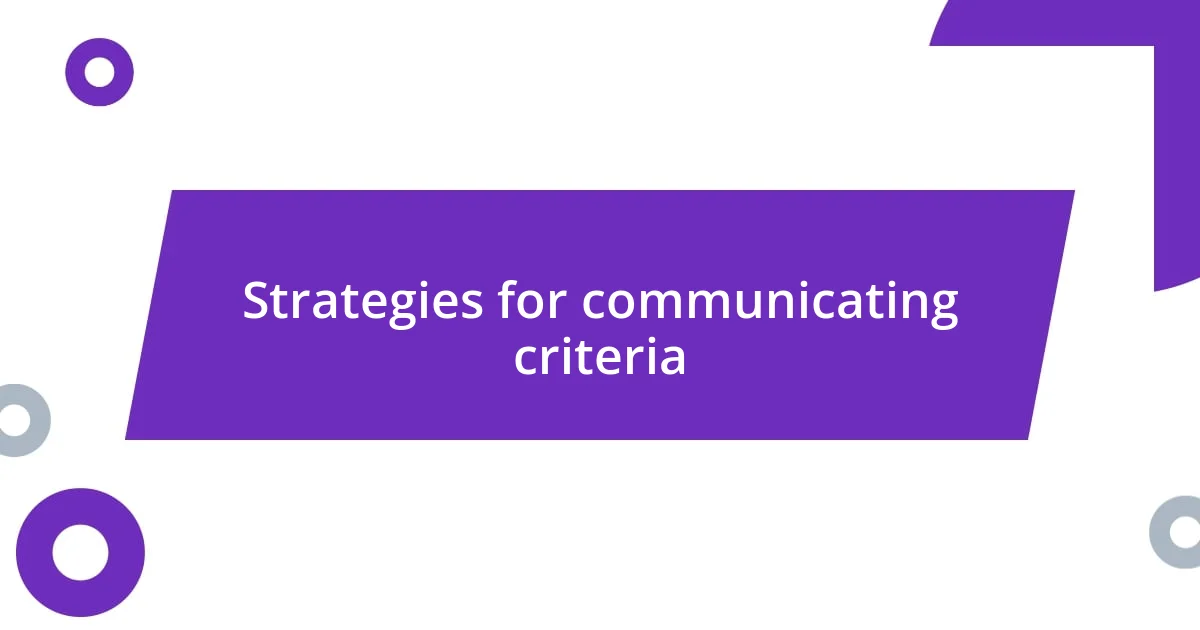Key takeaways:
- Transparent criteria enhance trust, motivation, and collaboration by clearly defining expectations in evaluations and projects.
- Establishing transparent criteria can face challenges such as resistance to change, the need for flexibility, and ensuring understanding among team members.
- Effective communication of criteria through visuals, regular check-ins, and storytelling can deepen understanding and foster a sense of ownership and accountability.

Understanding transparent criteria
Transparent criteria essentially serve as the guidelines that define expectations in various situations, whether in hiring, academic grading, or organizational assessments. They allow individuals to understand exactly what is required, which fosters a sense of trust and fairness. I remember a time when I faced a frustrating evaluation process that felt arbitrary; had there been clear criteria, it would have empowered me and my peers to excel rather than leaving us guessing.
When I think about transparent criteria, I can’t help but recall my experience during a team project. We struggled initially because we hadn’t established clear benchmarks for our goals. Once we laid out transparent criteria for success, everything shifted. Clarity boosted our motivation and collaboration; it made us feel like we were all on the same team, unified towards a common goal. Isn’t it fascinating how simple transparency can transform a group dynamic?
Transparent criteria can instill confidence and clarity, but they can also be challenging to establish. It requires honest dialogue and genuine collaboration among team members or stakeholders. Have you ever been part of a discussion where you felt unheard? That pivotal moment of inclusivity can make all the difference when criteria are being set and accepted. Transparent criteria aren’t just rules; they’re a collective understanding that encourages active participation and accountability.

Importance of clear evaluation
Clear evaluation is crucial because it lays the groundwork for fairness in any assessment process. From my experience, knowing exactly what I was being judged on—a project or a performance evaluation—was like having a roadmap. When the criteria were clearly defined, I felt more empowered to direct my efforts accordingly. I remember a particularly tough evaluation at work where ambiguity loomed large; the lack of clarity left many of my colleagues feeling disheartened.
- Confidence: Clear criteria bolster self-assurance, making it easier to engage with the evaluation process.
- Accountability: When everyone understands what is expected, it fosters a culture of responsibility.
- Motivation: Knowing the benchmarks can ignite a sense of determination to meet and exceed the standards.
In contrast, unclear evaluation criteria can often lead to frustration, as I experienced in a college course where grading seemed inconsistent. I often felt lost, unsure of where I stood and how to improve. It was like trying to hit a moving target—aggravating and discouraging. That’s why having transparent criteria is more than just a box to check; it’s about creating an environment that encourages growth, confidence, and even camaraderie.

Challenges in implementing transparent criteria
Establishing transparent criteria can often feel like treading through a minefield. One significant challenge I’ve faced is the resistance to change from stakeholders who are comfortable with the status quo. In my experience, introducing new criteria requires sensitive handling and education. When I was part of an initiative to overhaul performance evaluations, I discovered that many team members feared losing their longstanding privileges. Overcoming that inertia took time, patience, and a lot of open conversations.
Another hurdle is the balancing act between clarity and flexibility. I recall a project where we set very detailed criteria for success, which seemed effective at first. However, as the project evolved, some criteria became less relevant, and clinging too tightly to them stifled our creativity. I learned that while it’s essential to establish benchmarks, being adaptable and revisiting those benchmarks as circumstances change is key to staying effective. It’s almost like adjusting a recipe in the kitchen; sometimes you need to tweak the ingredients to achieve the best flavor.
Lastly, lack of understanding can sabotage the transparency effort. I remember during a training session when a few team members looked confused about the evaluation criteria we had just outlined. The silence in the room spoke volumes, and it dawned on me that we hadn’t done enough to ensure everyone felt comfortable asking questions. Creating transparent criteria isn’t solely about articulating what’s important; it’s also about fostering an environment where everyone feels safe to seek clarification and express concerns.
| Challenge | Description |
|---|---|
| Resistance to Change | Stakeholders may resist adopting new criteria due to comfort with existing norms. |
| Balancing Clarity and Flexibility | Too rigid criteria can stifle creativity; flexibility is essential as projects evolve. |
| Lack of Understanding | Team members need a safe space to ask questions about the criteria to ensure comprehension. |

Strategies for communicating criteria
When it comes to communicating criteria, I’ve found that clarity is key. It’s surprising how a simple visual aid—a chart or infographic—can make complex criteria feel more approachable. I once used a color-coded rubric to explain performance metrics in a team meeting. The moment I unveiled it, I saw expressions shift from puzzlement to understanding. Visuals not only encapsulate the information clearly but can also spark discussions that further solidify understanding. Have you ever noticed how a good visual can simplify even the most daunting topics?
Moreover, regular check-ins are a powerful strategy I’ve implemented. During ongoing projects, I would schedule brief sessions to discuss criteria progress with my team, allowing space for interaction. These meetings fostered an atmosphere of collaboration, where team members felt more comfortable voicing concerns or suggestions. Quite often, I’d find that addressing smaller questions in real-time prevented confusion later. Isn’t it fascinating how a little proactive communication can enhance a whole team’s clarity and engagement?
Lastly, I strongly believe in storytelling as a way to convey criteria effectively. Sharing personal anecdotes about how specific criteria impacted my journey—whether it was a time I exceeded an expectation or learned from a failure—helps to humanize the benchmarks. It makes the criteria not just a list of dos and don’ts but part of a collective experience. I remember sharing a story about a project that didn’t meet initial criteria but led to unexpected successes. It resonated with my team and encouraged a mindset shift towards viewing criteria as growth opportunities. What stories have you shared that made a difference in understanding?

Measuring the effectiveness of criteria
Measuring the effectiveness of criteria can often feel like an elusive task. I remember a project where we implemented a series of benchmarks to evaluate success. Initially, it was challenging to gauge whether these criteria were truly capturing our progress. Instead of relying solely on numbers, I started incorporating qualitative feedback from team members. This approach not only provided a more balanced view of our effectiveness, but it also encouraged ongoing dialogue. Have you ever wondered how important qualitative insights can be in revealing the true impact of our criteria?
Another aspect to consider is feedback loops. During one project, I piloted a system where team members rated the relevance of criteria after each milestone. The insights gathered were eye-opening. Some criteria that seemed critical at first became less vital, while others emerged as unexpected focal points. I realized that these reflections are the heart of the process. It raised an important question: How often do we take the time to reassess if our criteria serve their intended purpose?
Ultimately, the real measure of effective criteria lies in their ability to drive growth and innovation. I recall a scenario where rigid criteria stifled creativity among my peers. After realizing this, we allowed for amendments based on team input, which revitalized our project. Witnessing the positive shift in energy made me appreciate the importance of adaptability in our criteria. So, how do you ensure your criteria evolve alongside your team’s progress?

Case studies on successful transparency
One notable case study comes from a nonprofit organization that revamped its funding allocation process to enhance transparency. They began sharing detailed breakdowns of how funds were distributed, accompanied by a clear rationale for each decision. As a team member, I witnessed the shift in stakeholder confidence; funds that once seemed arbitrary were now perceived as fair and justified. Have you ever experienced a situation where transparency transformed trust?
Another fascinating example is from a tech startup that implemented an open-book management policy. Employees had access to financial data and performance metrics, which fostered a culture of ownership. I remember hearing from a colleague who initially felt distant from company goals but thrived once she saw how her day-to-day work impacted overall outcomes. Isn’t it amazing how transparency can engage individuals on a deeper level?
Lastly, let’s consider the educational sector where a school district introduced a transparent grading system. They utilized a progressive grading matrix that students and parents could access online. I recall discussing this during a parent-teacher conference where parents expressed gratitude for understanding exactly where their child stood academically. This real-time insight not only improved accountability but also encouraged students to take greater responsibility for their learning. Don’t you find it enlightening how clarity can create a more empowered community?














